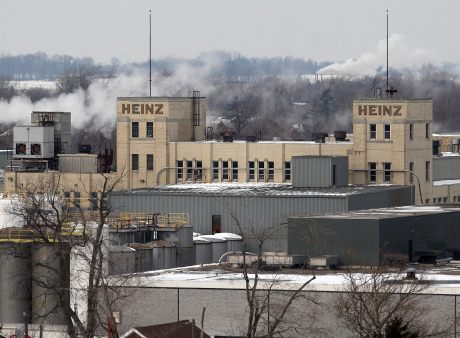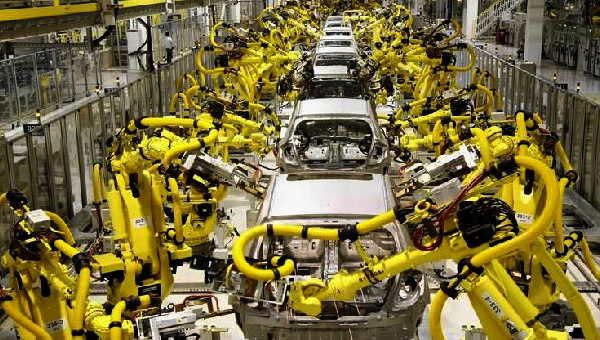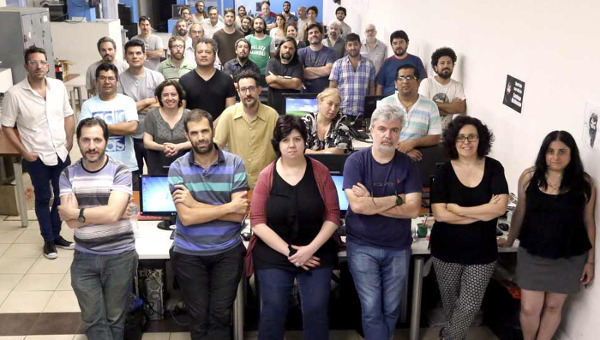The closure of the Leamington, Ontario Heinz factory by mid-2014 will result in 740 job losses in the industrial and agricultural region of southwestern Ontario between London and Windsor, Ontario. Over thirty tomato farms are losing contracts with Heinz which will also put 350 migrant worker jobs at risk.

The closure announcement comes only five months after Heinz was purchased by the Berkshire Hathaway hedge fund, which is behind the wave of factory closures. Warren Buffett, the world’s fourth wealthiest person, is the CEO and largest shareholder of Berkshire Hathaway which took control of Heinz in June 2013. Buffett is the same billionaire who made headlines a few years ago by saying wealth inequality was a problem and that the rich should be taxed more. Clearly Buffett doesn’t see his own investment activities as a driver of wealth inequality.
The plant closure has again exposed the inability of Ontario’s mainstream politics to develop an economic strategy that actually benefits the province’s working majority. Well-paying private sector jobs are vanishing amidst factory closures and deindustrialization in Canada’s manufacturing heartland. Electro-Motive Diesel in London, the blast furnace at U.S. Steel in Hamilton, the Redpath sugar refinery in Niagara, Bick’s in Dunnville, Chatham Navistar Assembly, and the St. Thomas Ford Assembly are just some of the victims in this trend.
The Impasse of Ontario’s Mainstream Politics
Ontario Premier Kathleen Wynne claimed to have done “everything” she could, but won’t disclose the details of her discussions with Heinz. Wynne has announced she will give $200,000 to help Leamington, even though the company pays $1.3-million in taxes to the city, county and school board each year.
Wynne’s response effectively amounts to complete incompetence. Robert Crawford, president of UFCW Local 459, which represents the workers, said “Very disappointed. Nothing is changing. The plant is closing.” This is the recent Liberal record with plant closures in Ontario: do nothing.
After bailing out the auto industry in 2008-09 with a no-strings-attached $3.5-billion loan, the same Ontario Liberals fear any intervention to save jobs. They are now highly unpopular, marred by scandal, have lost significant public sector worker support over Bill 115, and are steering a minority government against two parties which are at parity in the opinion polls.
The Liberals (and NDP) also know the PCs will try to capitalize on yet another private sector bailout, especially of a union workplace. The PCs were also able to build up anti-union support by highlighting the CAW-Liberal alliance dating back to the Anybody-But-Harris “strategic vote” of 1999.
Hudak’s Bogus “Right-to-Work” Solution
The Ontario Progressive Conservative solution to plant closures – and the province’s wider economic problems – is outlined in their policy paper Paths to Prosperity: Flexible Labour Markets. At the heart of their plan is “right-to-work” legislation which, they believe, would make Ontario more attractive to business investment.
The document even gives the example of the 2012 closure of London’s Electro-Motive Diesel (EMD) locomotive factory as a reason for right-to-work, saying that it will make Ontario “competitive.” But two of the other Heinz plants being closed are in the right-to-work states of South Carolina and Idaho. South Carolina has the second lowest unionization rate in the U.S.: 3.9 per cent. Idaho’s is 7.1 per cent. By comparison, Ontario’s is 28.2 per cent.
And after the Leamington closure announcement, Heinz announced it would invest $28-million in one of its Ohio factories. Ohio’s labour movement built an alliance with the wider public to defeat similar right-to-work legislation in 2011.
What Hudak is promising with right-to-work is a lie. Paths to Prosperity even cites jurisdictions with higher union density rates, like Newfoundland, Quebec, and Saskatchewan, as leading destinations for new investment and competitive threats to Ontario’s economy. There is simply no credible American study demonstrating that companies are attracted to right-to-work states. And while EMD jobs from London moved to right-to-work Indiana, it did so before right-to-work legislation was passed, and after the Indiana government offered
over $20-million in direct and indirect subsidies. Other factors, especially enormous government handouts and subsidies, are what convinces business to invest – not so-called right-to-work legislation.
Like the American Republicans who fight for right-to-work, the Ontario Tory cheerleading of right-to-work has nothing to do with economics, and everything to do with destroying union finances and labour’s potential to effect change. Right-to-work makes union dues optional regardless of whether or not someone benefits from a union-bargained contract. Undermining unions is part of their well-known pro-business agenda founded on their “free market” fantasies.
What About NDP Solutions?
If the Liberals are doing nothing, and the Tories want to actually make the situation worse, what would the NDP do as the governing party? It is difficult to see an NDP government going beyond anything but offering Heinz a large chunk of money in some form of subsidy. While it is true that even the unpopular NDP government of Bob Rae bailed out the Orion bus factory in Mississauga (which the Ontario Liberals let close in 2012 with 330 jobs lost), the NDP shows no signs of proposing this.
There is definitely no indication that the NDP will dust off its old, founding CCF policies of nationalizing industry and bringing it under state/public/government ownership. In fact, with the dropping of “socialism” from its constitution, the NDP has entrenched itself in a policy of conceding to established pro-business economic policies.
Even if nationalization was a realistic option from the NDP (or any other party), any form of expropriation of multinational property would run up against powerful international trade deals, like the North American Free Trade Agreement, or the recently-signed CETA deal with the European Union. These free trade deals allow corporations to sue elected governments which pass legislation deemed by corporations to violate so-called free trade rights. Government intervention to protect jobs, the environment, and even local business interests have been successfully challenged by corporations as “unfair trade practices.”
And the costs of government expropriation of multinational corporations are very costly even if they’re done without compensation. Take the case of the 2008 expropriation of Abitibi-Bowater’s property, water and forestry rights in Grand Falls-Windsor, Newfoundland. When the company announced the end of its Windsor-Grand Falls operation with the loss of 750 jobs, Premier Danny Williams (who is no friend of organized labour), stated:
“That corporation has the right to do whatever it has to do to keep their company profitable … but from my perspective as premier, and on behalf of people of Newfoundland and Labrador, we’re willing to tell them to go on and do their business in other parts of the country and other parts of the world…You came in with none of those resources, you leave with none of those resources, we wish you well.”
Under the Harper Tories, the federal Canadian government ended up paying Abitibi-Bowater $130-million for the expropriation to avoid an even costlier NAFTA legal case on the grounds that Williams’ legislation passed in the House of Assembly was “illegal.”
No one can reasonably expect the public to be in favour of footing such bills for otherwise principled and morally justified expropriations. It is no wonder mainstream political parties won’t take such actions. Any expropriation could also expect a predictably large and well-financed, well-propagated backlash from the Tories, much of the business class, and the media establishment. Those who can remember the grim Ontario NDP reign of 1990-95 may also recall the five-year propaganda campaign and ideological war waged by business groups against everything from rent controls, to anti-scab legislation, to pay equity for women.
A New Direction: Occupations, Cooperatives and Democracy
With no real choices offered by the three parties, Ontario’s workers and unions need new solutions that can confront immediate plant closures, while beginning to tackle the bigger economically-rooted problems of growing wealth inequality and climate crisis.
Organized labour’s current “strategies” against plant closure are going nowhere. As with Electro-Motive Diesel closure in London, union executives writing letters to federal cabinet ministers to request intervention or a review of foreign investment regulations has failed. Accepting concessions and two-tier contracts to “save jobs” is also failing, and not bringing jobs back in the numbers required. In fact, it’s turning younger unionized workers against their own unions which continually sell them out. And telling people to get jobs in Alberta isn’t going to help the climate crisis one bit. With Employment Insurance eligibility in Ontario at record lows (including below 30 per cent in mid-2012), our social safety net isn’t working either.
The immediate solution to the Heinz plant closure is a democratic decision by workers to takeover the plant and turn it into a cooperative under democratic self-management. This way the plant certainly won’t be shut down by its owners. The plant is also in the perfect location for what it produces. It is surrounded by tomato fields, and is located beside the 401 Highway for easy, rapid shipment to most of Ontario’s 12 million people, Quebec, and the populous American midwest and east coast. And it’s not like tomato products are going out of fashion anytime soon. The fact of cooperative, local ownership that saved jobs is a selling point in itself.
Allied with the labour movement, the cooperative could work to secure business in conjunction with a coordinated Heinz boycott. Labour-led consumer boycotts need to be part of our strategy. When EMD workers were locked out and closure on the horizon, a number of labour and community activists picketed Caterpillar dealerships. Many local businesses and even Mark’s Work Wearhouse and TSC pulled Cat products from their shelves. But the boycott’s potential was never harnessed by labour, coordinated, and expanded. In the end, CAW’s closure agreement at EMD actually forbade the union from pursuing a Caterpillar boycott. There is really nothing to lose in Leamington – except 740 jobs. [Support the Heinz factory employees on Facebook.]
Cooperative democratic ownership would also mean that the direct producers would not be polluting the very environment in which their families and neighbours live. This is critically important when we think about the climate crisis. As Naomi Klein said in
her speech at the founding Unifor Convention on September 1, 2013, labour can be at the forefront of tackling the climate crisis with a green economic strategy.
The Do-It-Ourselves Green Economy
We know tackling the climate crisis will require a transition to renewable energy of mainly wind and solar, a revolutionary expansion of urban and province-wide rail transit, and the retrofitting of every building for energy efficiency. The plant in Leamington would also contribute to a less polluting local solution to food production, instead of shipping in tomatos and tomato-based products from as far away as Mexico. Under democratic cooperative ownership, these decisions would be subject to democratic debate and decision-making where environmental and labour concerns and wider social responsibility would actually get a hearing (unlike in closed-door corporate board meetings).

Ontario ought to be at the forefront of such a transition because of its manufacturing base, but the plant closures are actually robbing Ontario, Canada and even North America of the critical industrial infrastructure required to make such a transition. Consider the closure of the Hamilton blast furnace and the loss of significant steelmaking capacities. EMD’s closure and loss of 450 jobs in February 2012 left only two locomotive assembly plants in Canada. In April 2014, Caterpillar is closing Canada’s only factory which builds the machines which bore subway tunnels. This means 330 job losses in Toronto – the same amount lost with the Orion bus factory closure, which supplied the huge Toronto transit system. Ontario is also seeing the decimation of a vast network of smaller autoparts plants with machine tools and the capability of various kinds of small-scale assembly. All these closed factories could be contributing to train, railway, windmill and solar panel construction, and retrofitting equipment and materials.
Plant occupations are nothing new. CAW occupied the Brampton Caterpillar plant in 1991 to secure a fair closure agreement. Ken Lewenza publicly threatened to occupy EMD in London if no closure agreement was secured. In 2004, workers in Arvida, Quebec went so far as to occupy and operate their aluminum plant under worker control to protest closure. The next step has been demonstrated in Argentina where workers took over abandoned factories and transformed them into democratic cooperatives, successfully defending the equipment and facilities from bailiffs and police through large pickets and protests, while simultaneously forcing governments to legally accept the transition to cooperatives.
What labour needs to do is occupy to save jobs, to develop cooperative, democratic ownership of the economy to curb the power of corporations, and to begin developing an economy that can actually address the climate crisis. Leamington could be a starting point, a beacon of hope for Ontario, Canada and the world. •





